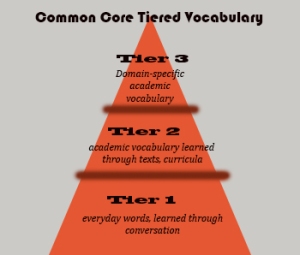 Have you ever been around someone who knows exactly the right word when they talk? Don’t you conclude they’re smart? Capable? The one you want in your study group? How about the inverse–an individual struggling with language, maybe picks words that aren’t quite right or can’t come up with one at all. What do you conclude then?
Have you ever been around someone who knows exactly the right word when they talk? Don’t you conclude they’re smart? Capable? The one you want in your study group? How about the inverse–an individual struggling with language, maybe picks words that aren’t quite right or can’t come up with one at all. What do you conclude then?
Teachers have always taught ‘vocabulary’ using labels like word study, site words, Dolch, Hi-Frequency words. Common Core considers proper terminology part and parcel to preparing for college and career. They fall into three types:
- Tier 1: Words acquired through every day speech, usually learned in early grades
- Tier 2: Academic words that appear in textbooks, precise words that refine meaning, i.e. ‘sprint’ instead of ‘run’.
- Tier 3: Domain specific words tied to content, included in glossaries, highlighted in textbooks, and considered important to understanding content.
The ‘tier’ you focus on in your teaching depends upon student age and material being taught. Here are five ways technology will make the time you spend on this subject more effective, fun, differentiated, and authentic:
- Context clues
- SpellingCity
- Online graphic dictionaries
- Word clouds
- Vocabulary websites
Before we begin, let’s lay some groundwork. Vocabulary (or word study) isn’t done in a vacuum. You don’t pass out lists and have students memorize words and definitions (you don’t do that, do you?). If you used to, that’s changed with Common Core. Now, you are expected to integrate vocab into learning. Every time students run into a term they don’t get, you need to pause and help them decode it. It may be obvious from context, its parts (roots and affixes), but always–always—pay attention so students know unfamiliar words are not skipped. With Common Core, every nuance is important. It’s about uncovering knowledge.
As a teacher, I love this. No longer does education treat ‘word study’ like something you get to if there’s time, or relegate to homework.
The shift for you is in ‘attention’—nothing else. Once you’ve trained yourself to use the right words and expect students to do the same, to pause every time confusion on their faces tell you they don’t understand, it will become as important to your teaching as differentiation. Like breathing.
Use these five strategies to let students experience the Wow of using exactly the right word. BTW, they can be used across all tiers.
Context Clues
The first step to meaning is context. ‘Context’ is not only surrounding words, but construction of the term itself. What is its root? Prefixes and suffixes? What clues do these parts provide to meaning?
Have students read something for class–any subject is fine–and find at least five unknown terms, Don’t research. Jot down each with its meaning based solely on context clues. Share via Google Docs (or a method of your choice) with a defense of their analysis.
Spelling City
This is ever-popular with 1st grade and up. Use it three ways:
- a themed word list from site
- a teacher-created list (requires fee-based account)
- student’s own words from class
Once a list is selected/created, the site provides activities (a test, a teach-me, games, flash cards) to help the student learn the words. This is great for class time or homework, easy to understand, intuitive to use, and never gets boring.
Graphic Dictionaries
Sure, students can use online resources like Dictionary.com or Thesaurus.com, but those won’t excite students about word study. They’re utilitarian, not inspirational (well, unless you’re a bibliophile like I am. I love reading the dictionary). Enhance the word-research experience with free sites like VisuWords or Lexipedia that visually represent the words and their meanings. Students type in a word and the site populates a mind-map of its definition and related words. This image makes it easy to find connections and relationships that assist with meaning, determine the perfect synonym, and better understand the shades of meaning inherent to our rich vocabulary.
Word Clouds
Where graphic dictionaries help you understand the fullness of a word, a word cloud helps you analyze a group of words. The most common example is tag clouds found on blogs, showing the most common words searched on the site. Students can produce this same effect using online tools like Tagxedo. Wordle or Tagul. Use any of the following ideas from Common Core to create word clouds:
- words from class
- synonyms
- prefixes
- suffixes
- roots
- word collections (i.e., precise actions, states of being, emotions, a particular topic)
Vocabulary websites
Finally, there is a massive grouping of sites that gamify the teaching of words, grammar, writing conventions and the like. Go through this list from Ask a Tech Teacher and pull out five-ten that your students can use in those snippets of time that would otherwise be wasted—right before lunch, for early-finishers of a project, while you’re finishing up with another student.
There you are–five ways to add automaticity to word study and scaffold vocabulary learning. One characteristic all of them have is they make words beautiful.
____________________________________________________________________________
Jacqui Murray has been teaching K-18 technology for 30 years. She is the editor/author of over a hundred tech ed resources including a K-12 technology curriculum, K-8 keyboard curriculum, K-8 Digital Citizenship curriculum. She is an adjunct professor in tech ed, Master Teacher, webmaster for four blogs, an Amazon Vine Voice, CSTA presentation reviewer, freelance journalist on tech ed topics, contributor to NEA Today, and author of the tech thrillers, To Hunt a Sub and Twenty-four Days. You can find her resources at Structured Learning.





































I really like this comprehensive list. I have a question: Teach Like a Champion recomends not to teach vocabulary using context clues, refer to page 272. Any thoughts? Our ELA ILS tells us (teachers) to use context clues.
I like Teach Like a Champion, but that piece I disagree with. When schools switched from phonics to whole language as an approach to vocabulary, it was to take the focus off the micro and think macro instead. Subsequent studies showed that to be less than successful for many groups of students, but highly effective for others. Common Core’s focus on the use of context clues (such as in the ELA Anchor Standards) brings the focus back to roots and affixes. For me personally, any way I can put tools in the hands of students that allow them to self-teach, I like.
What works best for you?